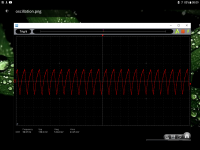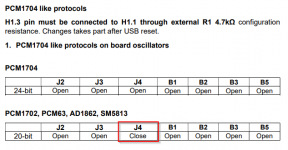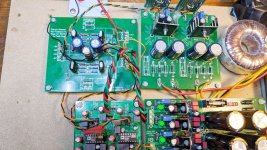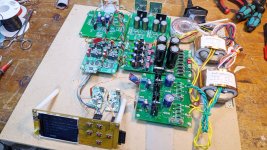Today I did more thorough testings of my LT3045 and LT3042 power supplies and would like to share the fun:
1) there are no more ocillations at idle or under load, since the voltage fluctuations are sparse and totally random when zoomed in. When I had oscillations, I could easily see regular wave patterns caused by the oscillation. Once the oscillations are removed, regular wave patterns are also gone ;
2) the 20 mv Vpp my scope showed me is actually limited by the smallest measuring unit my oscilloscope is capable of doing. I wasn't aware of this before. I wasn't happy with this 20 mv Vpp and was tearing my hairs out trying to trace it, until I zoomed in all the way to 2ns intervals and saw that the voltage was jumping up and down frome time to time at exactly 10 mv step each time. I realized that I was witnessing black magic! 10 mv, what a nice and consistent number! Hahaha! My power supplies are actually doing better than what I can measure! This has put a big smile on my face. What a relief😀😀😀
Hidy
1) there are no more ocillations at idle or under load, since the voltage fluctuations are sparse and totally random when zoomed in. When I had oscillations, I could easily see regular wave patterns caused by the oscillation. Once the oscillations are removed, regular wave patterns are also gone ;
2) the 20 mv Vpp my scope showed me is actually limited by the smallest measuring unit my oscilloscope is capable of doing. I wasn't aware of this before. I wasn't happy with this 20 mv Vpp and was tearing my hairs out trying to trace it, until I zoomed in all the way to 2ns intervals and saw that the voltage was jumping up and down frome time to time at exactly 10 mv step each time. I realized that I was witnessing black magic! 10 mv, what a nice and consistent number! Hahaha! My power supplies are actually doing better than what I can measure! This has put a big smile on my face. What a relief😀😀😀
Hidy
After long Time a post from me
Very strange problem i have. Did not listen to the dac for a while. Now its playing in mono! I really do not understand why
Must be glue Logic. I Cannot set my rpi streamer in mono somewhere
Any ideas?
Very strange problem i have. Did not listen to the dac for a while. Now its playing in mono! I really do not understand why
Must be glue Logic. I Cannot set my rpi streamer in mono somewhere
Any ideas?
Damned sourcing problems....the same as you... I have a still pre bom at mouser that wait for 5 months cause missing parts...
Btw the bipolar 1611 at i/v then the jfet 1656 as line buffer is also what I would do then voice the all with goods caps choice in relation on how the whole system sounds in the room (sort of little eq compensation by playing with caps)
OPA1656 is back in stock at mouser only a few days ago. But in the meantime only less than 100 are available. So ... hurry up 😉
Perhaps a silly question from a Miro Dac newbie....
I use the I2SoverUSB v.III from JLsounds with the Miro board rev1.3 PPY. I didn't install shift register part.
Where are the DL and DR lines connected on the JLsounds board?
I use the I2SoverUSB v.III from JLsounds with the Miro board rev1.3 PPY. I didn't install shift register part.
Where are the DL and DR lines connected on the JLsounds board?
I’m using PS2 and don’t seem to notice any oscillation. I don’t have a scope, but my meter readings are rock solid. So I need a scope in order to see any oscillation?
DL connects to H3 13, and DR connects to H3 9. Don’t forget that you are going to need 5v on H3 17 (5VDC) 19 (GND) to power the digital side. The other side is powered by the USB bus. Also a 4.7K resistor on H1 between pins 1 and 3.
Hi BRN,
My oscillation was running at a low frequency of 59 hz. Even so my meter wasn't fast enough to show it. My meter reading was rock solid too. It must have been showing an average voltage, which was indeed rock solid.

I wish I had bought an oscilloscope earlier. My oscillation had a range of 150mv and it didn't have any noticeable effects on sound effects. Only an oscilloscope can reveal it.
Right now, the scope I bought is going on sale at Newark for CAD 200 until Nov 31. The model nuber is MP720018 US. Its regular price is CAD 350. This is an oem version of the Owon VDS 2602. There is an even cheaper version (an oem version of the popular Owon VDS 1022i isolated USB) that is also on sale at CAD 100. A tremendous value.
I wish I had a PSU2 to test for you. I am sure that someone else with both a scope and the PUS2 would be happy to test PSU2.
My oscillation was running at a low frequency of 59 hz. Even so my meter wasn't fast enough to show it. My meter reading was rock solid too. It must have been showing an average voltage, which was indeed rock solid.

I wish I had bought an oscilloscope earlier. My oscillation had a range of 150mv and it didn't have any noticeable effects on sound effects. Only an oscilloscope can reveal it.
Right now, the scope I bought is going on sale at Newark for CAD 200 until Nov 31. The model nuber is MP720018 US. Its regular price is CAD 350. This is an oem version of the Owon VDS 2602. There is an even cheaper version (an oem version of the popular Owon VDS 1022i isolated USB) that is also on sale at CAD 100. A tremendous value.
I wish I had a PSU2 to test for you. I am sure that someone else with both a scope and the PUS2 would be happy to test PSU2.
Here's one that I've done a little work on recently. This one has SD card player as input, with Andrea Mori clocks, and the Pedja Rogic diamond buffer output stage, powered via a fairly simple 317 supply with a homemade denoizator.
The i2s lines are reclocked just as they enter the DAC.
The i2s lines are reclocked just as they enter the DAC.
Attachments
Bravo..awesome !
What's your listening feeling on this ? From my side the more the digital front end is tunned with care the better the ending result.
Worth to use the PS2 with some voltage adaptation for the Discroll boards and the PSU1 for the DAC instead ?
What's your listening feeling on this ? From my side the more the digital front end is tunned with care the better the ending result.
Worth to use the PS2 with some voltage adaptation for the Discroll boards and the PSU1 for the DAC instead ?
Last edited:
I've tried a good few power supplies with the Rogic output stage - shunts, jung type regs, even supercapacitors but this pretty simple reg wtih the denoizator matches them. Its the first time ever I think that a basic supply is not far outclassed by something more high performing.
Its a lovely stage - and if you search back you can find the gerbers that dvb-projekt posted several years back (with permission). They were made for TDA1541, so need a slight adaptation to 1862, but its simple. Also, if you match transistors half way near each other, and keep them thermally in contact then you won't need an output cap.
Every improvement on the front end can be heard....
Need I say this again.... this is a great DAC. If you want to take it to a higher level, use a good front end, good power supplies and a discrete output stage.
Its a lovely stage - and if you search back you can find the gerbers that dvb-projekt posted several years back (with permission). They were made for TDA1541, so need a slight adaptation to 1862, but its simple. Also, if you match transistors half way near each other, and keep them thermally in contact then you won't need an output cap.
Every improvement on the front end can be heard....
Need I say this again.... this is a great DAC. If you want to take it to a higher level, use a good front end, good power supplies and a discrete output stage.
Yes i am aware of it, look at Painkiller thread about ad1862 that made the same on two mono pcb...I have the dac and writted in the thread. Did it with the BC550/560C in close contact and a Rhopoint resistor for the i/v 😉
@Hidy
Nice story about measuring the oscillations in your PSU 😉
@tubee
I bet it is something with the RPI strimmer (settings?) ... glue logic does one thing: divides the left and right channels using buffer, and if the streamer sends mono, than the mono will be played, if it sends stereo, than the stereo will be played 🙂
@woodturner-fran
As always, very valuable DIY info from you, this time about the PSU 🙂
I said it many times: Do it as simple as possible, but not simplier 😀 Finding the simplicity is the key
Nice story about measuring the oscillations in your PSU 😉
@tubee
I bet it is something with the RPI strimmer (settings?) ... glue logic does one thing: divides the left and right channels using buffer, and if the streamer sends mono, than the mono will be played, if it sends stereo, than the stereo will be played 🙂
@woodturner-fran
As always, very valuable DIY info from you, this time about the PSU 🙂
I said it many times: Do it as simple as possible, but not simplier 😀 Finding the simplicity is the key

Last edited:
I said it many times: Do it as simple as possible, but not simplier Finding the simplicity is the key
Couldn't agree more! You could also add "using widely available and cheap parts!" to that as well.
Its a lovely stage - and if you search back you can find the gerbers that dvb-projekt posted several years back (with permission). They were made for TDA1541, so need a slight adaptation to 1862, but its simple. Also, if you match transistors half way near each other, and keep them thermally in contact then you won't need an output cap.
Do you mean this?
I have begun purchasing parts for my build. I have another question, and I don't know if it's thoughtful or misguided.
Is it possible to modify the present I/V stage or substitute it for one that outputs >4Vrms so I can bypass a preamp stage?
Is it possible to modify the present I/V stage or substitute it for one that outputs >4Vrms so I can bypass a preamp stage?
What modifications did you have to make to Rogic's output stage? I'd definitely like to give it a try with the AD1862. 🙂
I've tried a good few power supplies with the Rogic output stage - shunts, jung type regs, even supercapacitors but this pretty simple reg wtih the denoizator matches them. Its the first time ever I think that a basic supply is not far outclassed by something more high performing.
Its a lovely stage - and if you search back you can find the gerbers that dvb-projekt posted several years back (with permission). They were made for TDA1541, so need a slight adaptation to 1862, but its simple. Also, if you match transistors half way near each other, and keep them thermally in contact then you won't need an output cap.
Every improvement on the front end can be heard....
Need I say this again.... this is a great DAC. If you want to take it to a higher level, use a good front end, good power supplies and a discrete output stage.
- Home
- Source & Line
- Digital Line Level
- DAC AD1862: Almost THT, I2S input, NOS, R-2R


